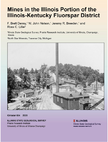Mine Index 10106416 Rosiclare Lead And Fluorspar Mining Company, Dimick Mine, Dimmick Prospect Shaft No 2
| Disclaimer | ||
|---|---|---|
| S-T-R | 28(NW)-12S-8E | |
| County: | Hardin | |
| Quadrangle: | Rosiclare | |
| District: | Fluorspar District | |
| Subdistrict: | Rosiclare Subdistrict | |
Mine Index Number: 10106416
| ISGS ID: | MSHA ID: | ||
|---|---|---|---|
| MAS ID: | 170690117 | MRDS ID: | W062450 |
| Company Name: | Rosiclare Lead And Fluorspar Mining Company | ||
| Mine/Site Name: | Dimick Mine, Dimmick Prospect Shaft No 2 | ||
| Active/Abandoned: | Abandoned | ||
| Start Date: | circa 1975 | End Date: | Unknown |
| Commodity Type: | Non-Metallic | ||
| Commodity: | Fluorspar | ||
| Minerals Present: | Fluorite | ||
| Type of Mine: | Underground | ||
| District: | Fluorspar District | Subdistrict: | Rosiclare Subdistrict |
| County: | Hardin | ||
| Section/Township/Range: | 28(NW)-12S-8E | ||
| Latitude,Longitude: | 37.4481299999999,-88.32948 | ||
| Unit(s) Mined: | Valmeyeran Series, Aux Vases Sandstone, Ste. Genevieve Limestone, St. Louis Sandstone | ||
| Feature(s) Mined: | |||
| MRDS Link: | https://mrdata.usgs.gov/mrds/show-mrds.php?dep id=10106416 | ||
| Mindat link: | |||
Discussion
The Dimmick property was situated in the northern part of the Rosiclare Subdistrict, north of the Daisy Mine and southwest of the Eureka Mine (Baxter and Desborough 1965). Dimmick is also spelled “Dimick” (Weller et al. 1952). Prospecting commenced circa 1918 via open pits, shallow exploration shafts, and diamond core drilling. The property passed through several hands before W.E. Dimmick sank a shaft 200 feet deep and began drift development sometime in the 1930s. Veins more than 5 feet wide were encountered in Dimmick’s mine, but little stoping was conducted. After Dimmick’s death circa 1938, the mine passed to the Hillside Fluorspar Mines Company, which cleaned out old workings, sank a second shaft, and resumed production in 1942 (Davis 1943). The Dimmick No. 2 Shaft was sunk to 65 feet deep and a drift was driven 80 feet along a fault, but no mineralization was encountered (Bastin 1931). The workings encompassed two subparallel veins striking slightly east of north, dipping almost vertically, and merging toward the south (Weller 1942b). Illinois Coal Reports indicate that approximately 5,000 tons of ore was produced by Dimmick during the 1920s to 1930s.
Mine Data/Information
References
|
|
|
External Links
Mineral Resources Data System (MRDS) USGS Link
https://mrdata.usgs.gov/mrds/show-mrds.php?dep id=10106416
Also referenced as 10193583

